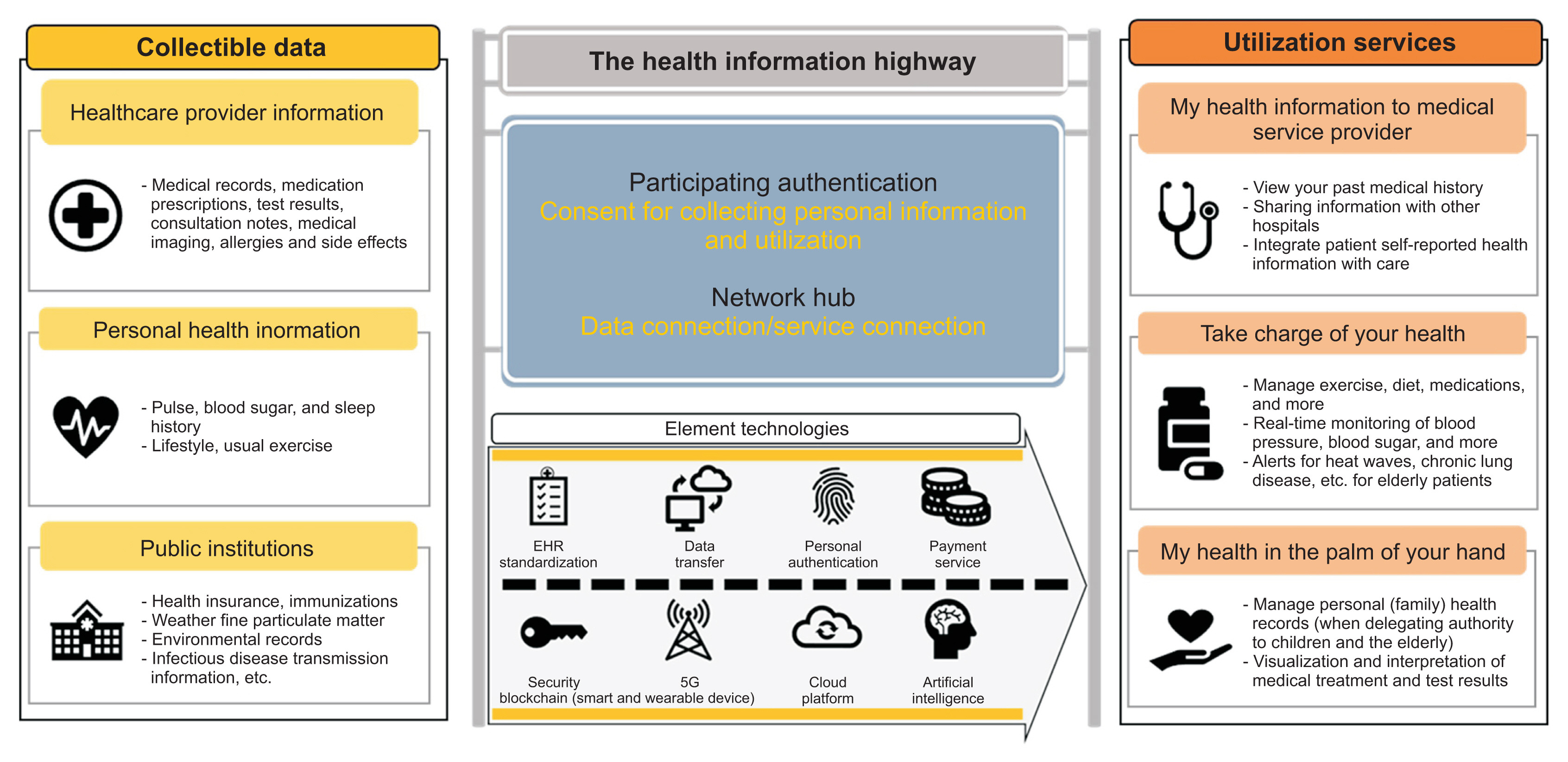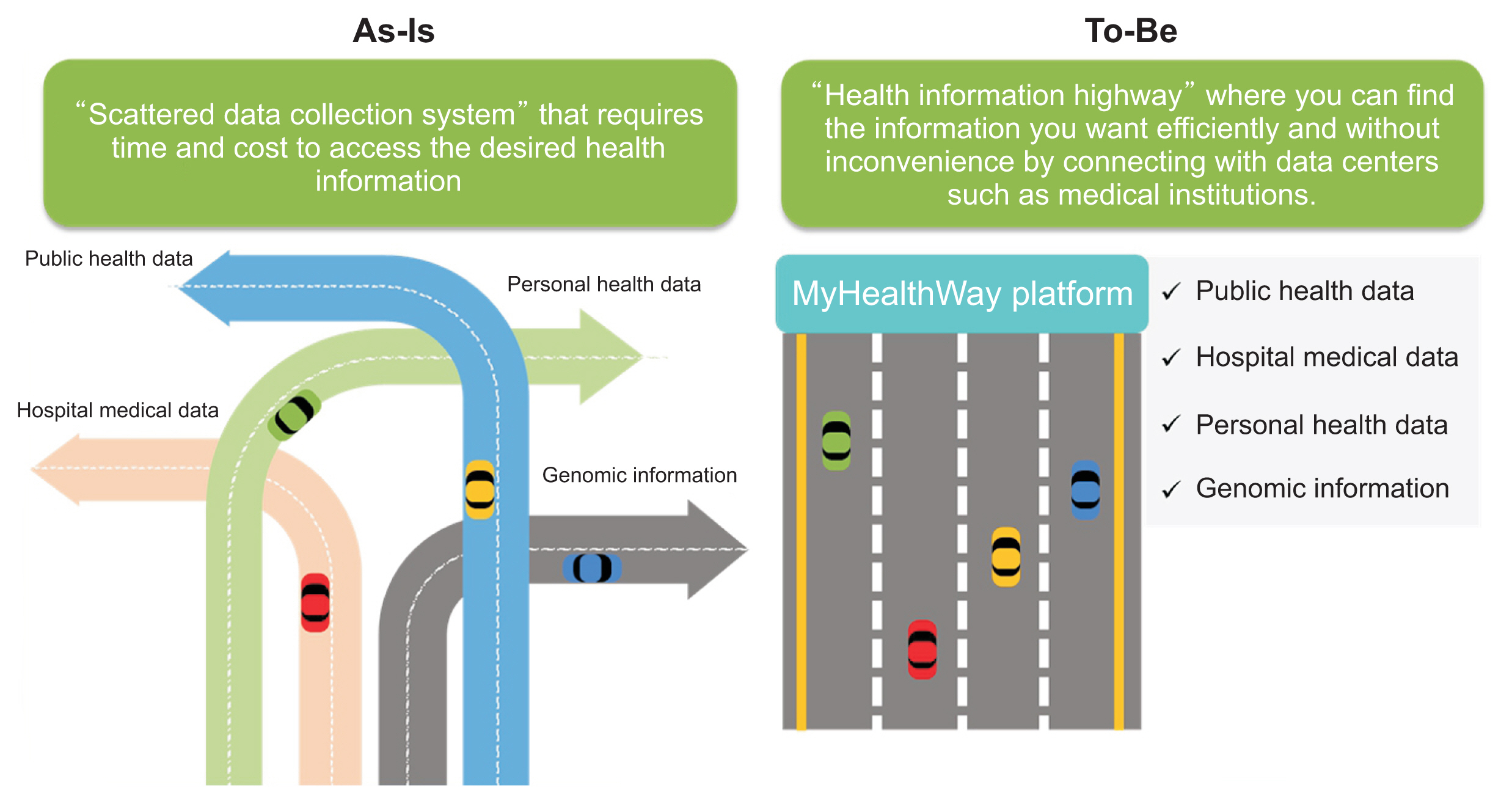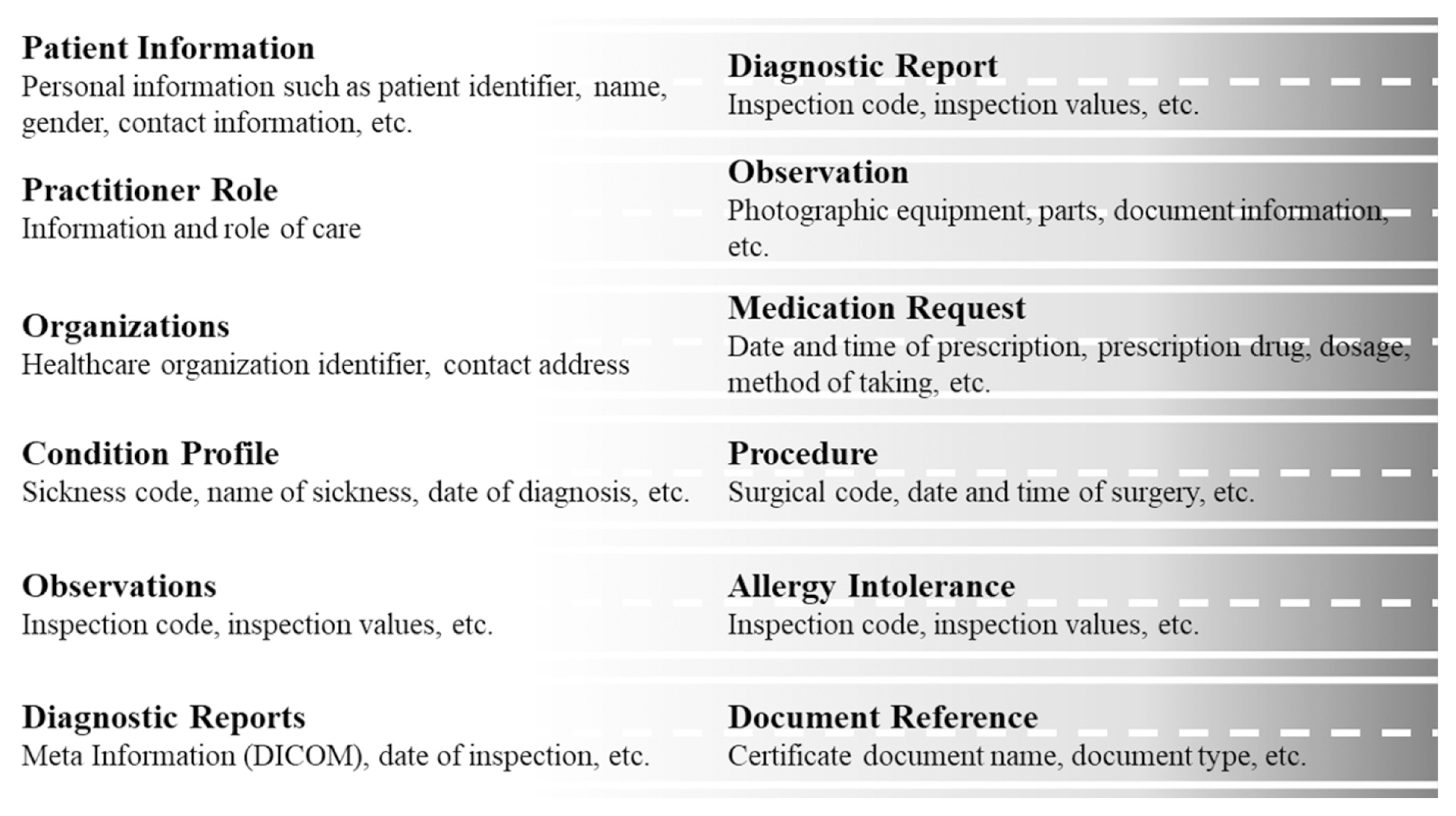Healthc Inform Res.
2024 Apr;30(2):103-112. 10.4258/hir.2024.30.2.103.
Status of MyHealthWay and Suggestions for Widespread Implementation, Emphasizing the Utilization and Practical Use of Personal Medical Data
- Affiliations
-
- 1Department of Biomedical Research Institute, Kangwon National University Hospital, Chuncheon, Korea
- 2Department of Convergence Security, Kangwon National University, Chuncheon, Korea
- 3Department of Medical Bigdata Convergence, Kangwon National University, Chuncheon, Korea
- 4University-Industry Cooperation Foundation, Kangwon National University, Chuncheon, Korea
- 5Department of Medical Informatics, Kangwon National University School of Medicine, Chuncheon, Korea
- 6Department of Internal Medicine, Kangwon National University Hospital, Kangwon National University School of Medicine, Chuncheon, Korea
- 7Department of Artificial Intelligence Convergence, Kangwon National University, Chuncheon, Korea
- 8Department of Neurology, Kangwon National University Hospital, Chuncheon, Korea
- 9Institute of Medical Science, Kangwon National University School of Medicine, Chuncheon, Korea
- KMID: 2555210
- DOI: http://doi.org/10.4258/hir.2024.30.2.103
Abstract
Objectives
In the Fourth Industrial Revolution, there is a focus on managing diverse medical data to improve healthcare and prevent disease. The challenges include tracking detailed medical records across multiple institutions and the necessity of linking domestic public medical entities for efficient data sharing. This study explores MyHealthWay, a Korean healthcare platform designed to facilitate the integration and transfer of medical data from various sources, examining its development, importance, and legal implications.
Methods
To evaluate the management status and utilization of MyHealthWay, we analyzed data types, security, legal issues, domestic versus international issues, and infrastructure. Additionally, we discussed challenges such as resource and infrastructure constraints, regulatory hurdles, and future considerations for data management.
Results
The secure sharing of medical information via MyHealthWay can reduce the distance between patients and healthcare facilities, fostering personalized care and self-management of health. However, this approach faces legal challenges, particularly relating to data standardization and access to personal health information. Legal challenges in data standardization and access, particularly for secondary uses such as research, necessitate improved regulations. There is a crucial need for detailed governmental guidelines and clear data ownership standards at institutional levels.
Conclusions
This report highlights the role of Korea's MyHealthWay, which was launched in 2023, in transforming healthcare through systematic data integration. Challenges include data privacy and legal complexities, and there is a need for data standardization and individual empowerment in health data management within a systematic medical big data framework.
Figure
Cited by 1 articles
-
Status and Trends of the Digital Healthcare Industry
Na Kyung Lee, Jong Seung Kim
Healthc Inform Res. 2024;30(3):172-183. doi: 10.4258/hir.2024.30.3.172.
Reference
-
References
1. Min BW. An improvement of personalized computer aided diagnosis probability for smart healthcare service system. J Converg Soc SMB. 2016; 6(4):79–84. https://doi.org/10.22156/CS4SMB.2016.6.4.079.
Article2. Kang YN, Seol YJ. Cancer diagnosis and treatment using big data in healthcare. HIRA Bigdata Brief. 2019. 3(4):6–27. https://repository.hira.or.kr/handle/2019.oak/2244.3. Liu YT, Jeon HM, Ban YH. A smart healthcare service with O2O: focus on healthcare company in Shenzhen. J Korean Des Cult Soc. 2018; 24(2):231–39. https://doi.org/10.18208/ksdc.2018.24.2.231.
Article4. Choi YH, Jeong IY. Vitalizing the smart healthcare ecosystem through healthcare data exchange. KIET Issue Paper. 2017; 2017:436.5. Lee KH. Current status of MyData policy and tasks in health and welfare. Health Welf Forum. 2021; 11(301):52–68. https://doi.org/10.23062/2021.11.5.
Article6. Lee NJ, Lee JH, Yeo YA. How Individual characteristics effect the decision making process regarding health care data provision and disclosure. J Korean Contents Soc. 2023; 23(2):597–609. http://doi.org/10.5392/JKCA.2023.23.02.597.
Article7. Shin SY. Standardize unstructured healthcare data. Inf Commun Mag. 2018; 35(2):158–64.8. Bae JK. A study on the legal and institutional factors for activation of MyData industry. Logos Manag Res. 2021; 19(1):117–32.9. Choi JM, Jo YE. A study on the right to data portability and MyData industry. J Law Econ Regul. 2020; 13(2):92–107. https://doi.org/10.22732/CeLPU.2020.13.2.92.
Article10. Oh MA. Canadian administrative data and public data linkage in health, welfare and social security. Int Soc Secur Rev. 2020; (14):53–64. https://doi.org/10.23063/2020.09.5.
Article11. Lee HJ. The legislation on the Personal Medical Information Protection Law. Korean J Med Law. 2014; 22(1):177–208.
Article12. Choi J, Park H, Chie EK, Choi SW, Lee HY, Yoo S, et al. Current status and key issues of data management in tertiary hospitals: a case study of Seoul National University Hospital. Healthc Inform Res. 2023; 29(3):209–17. https://doi.org/10.4258/hir.2023.29.3.209.
Article13. Korea Health and Medical Information Service. Medical data-centered hospital data portal [Internet]. Seoul, Korea: Korea Health and Medical Information Service;c2023. [cited at 2024 Apr 28]. Available from: https://www.hins.or.kr/index.es?sid=a3.14. Kim JH, Shin JY. Survey of overseas cases for introducing MyData in the domestic medical field. Health Ind Brief. 2022; 368:2–10.15. Yi M. Comparison of MyData use among the U.S., Europe, and the Korean governments. J Korean BIBLIA Soc Lib Inf Sci. 2020; 31(2):183–201. https://doi.org/10.14699/kbiblia.2020.31.2.183.
Article16. Kim YM. A study on the activation of health care big data: focusing on the Finnish case. Wonkwang Leg Res Inst Bio-Med Law. 2019; 22:5–38. https://doi.org/10.22397/bml.2018.20.05.
Article17. Yoon HS. A search for a legal system allowing the safe use of health data: a case study on the Finnish Act on the secondary use of health and social data. J Law Econ Regul. 2021; 14(2):30–59. https://doi.org/10.22732/CeLPU.2021.14.2.30.
Article18. European Commission. The European Health Data Space: harnessing the power of health data for people, patients, and innovation [Internet]. Brussels, Belgium: European Commission;c2023. [cited at 2024 Apr 28]. Available from: https://www.european-health-data-space.com.19. European Commission. European Health Union: the European Health Data Space for people and science [Internet]. Brussels, Belgium: European Commission;c2023. [cited at 2024 Apr 28]. Available from: https://commission.europa.eu/strategy-and-policy/priorities-2019-2024/promoting-our-european-way-life/european-health-union_en.20. Yoon GH. Hope and huddles of health big data use. HIRA Rep. 2020; 14(3):7–14.21. Byun S. A study on the proposal of a personnel healthcare record My-Data utilization model to revitalize ecommerce. The e-Bus Stud. 2021; 22(5):3–14. https://doi.org/10.20462/tebs.2021.10.22.5.3.
Article22. Mok GS. The ethical use of biomedical big data: shifting from a consent model to an agreement model. Korean J Med Ethics. 2019; 22(1):1–19. https://doi.org/10.35301/ksme.2019.22.1.1.
Article23. Park J, Lee Y. Empowering MyHealthway and activating digital healthcare through the introduction of right to personal information transfer under Personal Information Protection Act. Korean J Med Law. 2023; 31(1):111–35. https://doi.org/10.17215/kaml.2023.06.31.1.111.
Article24. Health and Welfare Committee. Bill on Promotion of Digital Healthcare and Promotion of Utilization of Healthcare Data [Internet]. Seoul, Korea: Health and Welfare Committee;2023. [cited 2024 Apr 28]. Available from: https://pal.assembly.go.kr/napal/search/lgsltpaSearch/view.do?lgsltPaId=PRC_P2N3O0W9U0V4T1U-1S3T9B5Z0Z2Y7Z4.25. Kang HJ. National-level use of health care big data and its policy implications. Health Welf Forum. 2016; 238:55–71. https://doi.org/10.23062/2016.08.6.
Article26. Jeon SJ, Joo MH, Kwon HY. Legal issues on guideline for personal information de-identification measures. J Korea Inf Law. 2016; 20(3):259–90.27. Min KY. MyData status survey. Seoul, Korea: Korea Data Industry Promotion Agency;2019.28. Min KY. MyData service guide. Seoul, Korea: Korea Data Industry Promotion Agency;2019.29. Kim DG, Hong CE. Legal research on the protection of MyData after the Data 3 Act. Wonkwang Law Rev. 2020; 36(2):63–91. https://doi.org/10.22397/wlri.2020.36.2.63.
Article
- Full Text Links
- Actions
-
Cited
- CITED
-
- Close
- Share
- Similar articles
-
- Impacts of Implementation of Patient Referral System in terms of Medical Expenditures and Medical Utilization
- Evaluating the Landscape of Personal Health Records in Korea: Results of the National Health Informatization Survey
- Factors associated with health services utilization between the years 2010 and 2012 in Korea: using Andersen's Behavioral model
- The effects of insurance coverage on the medical care utilization in public health institutions in a rural area
- Determinants of Nutrition Service Utilization in Health Centers




